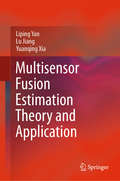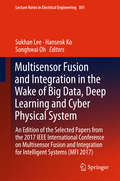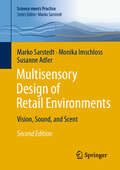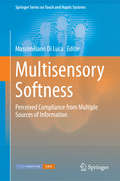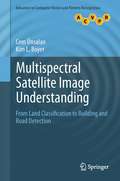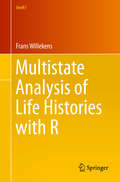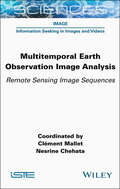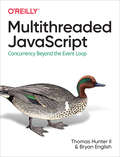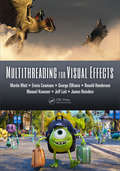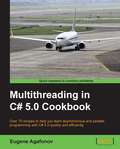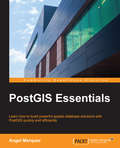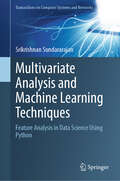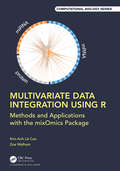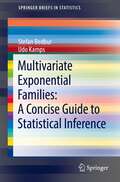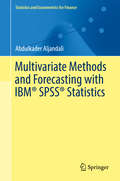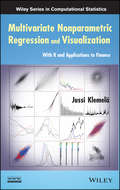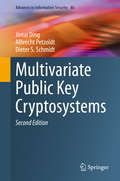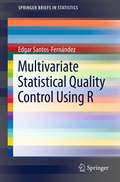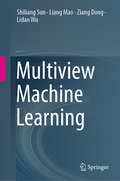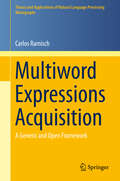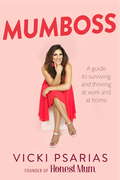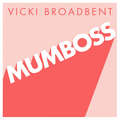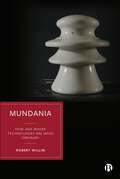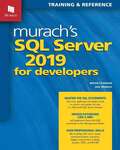- Table View
- List View
Multisensor Fusion Estimation Theory and Application
by Yuanqing Xia Lu Jiang Liping YanThis book focuses on the basic theory and methods of multisensor data fusion state estimation and its application. It consists of four parts with 12 chapters. In Part I, the basic framework and methods of multisensor optimal estimation and the basic concepts of Kalman filtering are briefly and systematically introduced. In Part II, the data fusion state estimation algorithms under networked environment are introduced. Part III consists of three chapters, in which the fusion estimation algorithms under event-triggered mechanisms are introduced. Part IV consists of two chapters, in which fusion estimation for systems with non-Gaussian but heavy-tailed noises are introduced. The book is primarily intended for researchers and engineers in the field of data fusion and state estimation. It also benefits for both graduate and undergraduate students who are interested in target tracking, navigation, networked control, etc.
Multisensor Fusion and Integration in the Wake of Big Data, Deep Learning and Cyber Physical System: An Edition of the Selected Papers from the 2017 IEEE International Conference on Multisensor Fusion and Integration for Intelligent Systems (MFI 2017) (Lecture Notes in Electrical Engineering #501)
by Sukhan Lee Hanseok Ko Songhwai OhThis book includes selected papers from the 13th IEEE International Conference on Multisensor Integration and Fusion for Intelligent Systems (MFI 2017) held in Daegu, Korea, November 16–22, 2017. It covers various topics, including sensor/actuator networks, distributed and cloud architectures, bio-inspired systems and evolutionary approaches, methods of cognitive sensor fusion, Bayesian approaches, fuzzy systems and neural networks, biomedical applications, autonomous land, sea and air vehicles, localization, tracking, SLAM, 3D perception, manipulation with multifinger hands, robotics, micro/nano systems, information fusion and sensors, and multimodal integration in HCI and HRI. The book is intended for robotics scientists, data and information fusion scientists, researchers and professionals at universities, research institutes and laboratories.
Multisensory Design of Retail Environments: Vision, Sound, and Scent (Science meets Practice)
by Marko Sarstedt Monika Imschloss Susanne AdlerOnline retailers have gained massive popularity in recent years, plunging large parts of brick-and-mortar retail into an existential crisis. In order to survive in times of growing online retail, brick-and-mortar retailers must become aware of their unique potential to address non-digitizable consumer needs and transform retail environments into places of experience and discovery. A key building block for achieving this aim lies in the creation of sensory experiences that motivate consumers to enter and linger in stationary retail environments. But how? To answer this question, this volume provides insights into the latest research results from sensory marketing on vision, sound, and scent. The authors describe the sometimes surprising effects of sensory cues on consumer behavior and provide clear recommendations for marketing practice. The second edition comes with an advanced coverage of various topics such as technology use in retail environments and includes new case studies.
Multisensory Softness
by Massimiliano Di LucaOffers a unique multidisciplinary overview of how humans interact with soft objects and how multiple sensory signals are used to perceive material properties, with an emphasis on object deformability. The authors describe a range of setups that have been employed to study and exploit sensory signals involved in interactions with compliant objects as well as techniques to simulate and modulate softness - including a psychophysical perspective of the field. Multisensory Softness focuses on the cognitive mechanisms underlying the use of multiple sources of information in softness perception. Divided into three sections, the first Perceptual Softness deals with the sensory components and computational requirements of softness perception, the second Sensorimotor Softness looks at the motor components of the interaction with soft objects and the final part Artificial Softness focuses on the identification of exploitable guidelines to help replicate softness in artificial environments.
Multispectral Satellite Image Understanding
by Kim L. Boyer Cem ÜnsalanThis book presents a comprehensive review of image processing methods, for the analysis of land use in residential areas. Combining a theoretical framework with highly practical applications, the book describes a system for the effective detection of single houses and streets in very high resolution. Topics and features: with a Foreword by Prof. Dr. Peter Reinartz of the German Aerospace Center; provides end-of-chapter summaries and review questions; presents a detailed review on remote sensing satellites; examines the multispectral information that can be obtained from satellite images, with a focus on vegetation and shadow-water indices; investigates methods for land-use classification, introducing precise graph theoretical measures over panchromatic images; addresses the problem of detecting residential regions; describes a house and street network-detection subsystem; concludes with a summary of the key ideas covered in the book.
Multistate Analysis of Life Histories with R
by Frans WillekensThis book provides an introduction to multistate event history analysis. It is an extension of survival analysis, in which a single terminal event (endpoint) is considered and the time-to-event is studied. Multistate models focus on life histories or trajectories, conceptualized as sequences of states and sequences of transitions between states. Life histories are modeled as realizations of continuous-time Markov processes. The model parameters, transition rates, are estimated from data on event counts and populations at risk, using the statistical theory of counting processes. The Comprehensive R Network Archive (CRAN) includes several packages for multistate modeling. This book is about Biograph. The package is designed to (a) enhance exploratory analysis of life histories and (b) make multistate modeling accessible. The package incorporates utilities that connect to several packages for multistate modeling, including survival, eha, Epi, mvna etm, mstate, msm, and TraMineR for sequence analysis. The book is a 'hands-on' presentation of Biograph and the packages listed. It is written from the perspective of the user. To help the user master the techniques and the software, a single data set is used to illustrate the methods and software. It is the subsample of the German Life History Survey, which was also used by Blossfeld and Rohwer in their popular textbook on event history modeling. Another data set, the Netherlands Family and Fertility Survey, is used to illustrate how Biograph can assist in answering questions on life paths of cohorts and individuals. The book is suitable as a textbook for graduate courses on event history analysis and introductory courses on competing risks and multistate models. It may also be used as a self-study book. The R code used in the book is available online. Frans Willekens is affiliated with the Max Planck Institute for Demographic Research (MPIDR) in Rostock, Germany. He is Emeritus Professor of Demography at the University of Groningen, a Honorary Fellow of the Netherlands Interdisciplinary Demographic Institute (NIDI) in the Hague, and a Research Associate of the International Institute for Applied Systems Analysis (IIASA), Laxenburg, Austria. He is a member of Royal Netherlands Academy of Arts and Sciences (KNAW). He has contributed to the modeling and simulation of life histories, mainly in the context of population forecasting.
Multitemporal Earth Observation Image Analysis: Remote Sensing Image Sequences (ISTE Invoiced)
by Clément Mallet Nesrine ChehataEarth observation has witnessed a unique paradigm change in the last decade with a diverse and ever-growing number of data sources. Among them, time series of remote sensing images has proven to be invaluable for numerous environmental and climate studies. Multitemporal Earth Observation Image Analysis provides illustrations of recent methodological advances in data processing and information extraction from imagery, with an emphasis on the temporal dimension uncovered either by recent satellite constellations (in particular the Sentinels from the European Copernicus programme) or archival aerial images available in national archives. The book shows how complementary data sources can be efficiently used, how spatial and temporal information can be leveraged for biophysical parameter estimation, classification of land surfaces and object tracking, as well as how standard machine learning and state-of-the-art deep learning solutions can solve complex problems with real-world applications.
Multithreaded Javascript: Concurrency Beyond the Event Loop
by Thomas Hunter II Bryan EnglishTraditionally, JavaScript has been a single-threaded language. Nearly all online forum posts, books, online documentation, and libraries refer to the language as single threaded. Thanks to recent advancements in the language--such as the Atomics and SharedArrayBuffers objects and Web Workers in the browser--JavaScript is now a multi-threaded language. These features will go down as being the biggest paradigm shift for the world's most popular programming language.Multithreaded JavaScript explores the various features that JavaScript runtimes have at their disposal for implementing multithreaded programming, providing both practical real-world examples, as well as reference material.Learn what multithreaded programming is and how you can benefit from itUnderstand the differences between a web worker, a service worker, and a worker threadKnow when and when not to use threads in an applicationOrchestrate communication between threads by leveraging the Atomics objectBuild high-performance applications using the knowledge you gain from this bookBenchmark performance to learn if you'll benefit from multithreading
Multithreading for Visual Effects
by James Reinders Martin Watt Erwin Coumans George ElKoura Ronald Henderson Manuel Kraemer Jeff LaitTackle the Challenges of Parallel Programming in the Visual Effects IndustryIn Multithreading for Visual Effects, developers from DreamWorks Animation, Pixar, Side Effects, Intel, and AMD share their successes and failures in the messy real-world application area of production software. They provide practical advice on multithreading techniques and
Multithreading in C# 5.0 Cookbook
by Eugene AgafonovCookbook.Multithreading in C# 5.0 Cookbook is written for existing C# developers who want a complete, professional, and authoritative guide to multithreading. You don't need any experience with multithreaded programming to use this book.
Multithreading with C# Cookbook - Second Edition
by Eugene AgafonovOver 70 recipes to get you writing powerful and efficient multithreaded, asynchronous, and parallel programs in C# 6.0 About This Book * Rewritten and updated to take advantage of the latest C# 6 features * Learn about multithreaded, asynchronous, and parallel programming through hands-on, code-first examples * Use these recipes to build fast, scalable, and reliable applications in C# Who This Book Is For This book is aimed at those who are new to multithreaded programming, and who are looking for a quick and easy way to get started. It is assumed that you have some experience in C# and .NET already, and you should also be familiar with basic computer science terminology and basic algorithms and data structures. What You Will Learn * Use C# 6.0 asynchronous language features * Work with raw threads, synchronize threads, and coordinate their work * Develop your own asynchronous API with Task Parallel Library * Work effectively with a thread pool * Scale up your server application with I/O threads * Parallelize your LINQ queries with PLINQ * Use common concurrent collections * Apply different parallel programming patterns * Use Reactive Extensions to run asynchronous operations and manage their options In Detail Multi-core processors are synonymous with computing speed and power in today's world, which is why multithreading has become a key concern for C# developers. Multithreaded code helps you create effective, scalable, and responsive applications. This is an easy-to-follow guide that will show you difficult programming problems in context. You will learn how to solve them with practical, hands-on, recipes. With these recipes, you'll be able to start creating your own scalable and reliable multithreaded applications. Starting from learning what a thread is, we guide you through the basics and then move on to more advanced concepts such as task parallel libraries, C# asynchronous functions, and much more. Rewritten to the latest C# specification, C# 6, and updated with new and modern recipes to help you make the most of the hardware you have available, this book will help you push the boundaries of what you thought possible in C#. Style and approach This is an easy-to-follow guide full of hands-on examples of real-world multithreading tasks. Each topic is explained and placed in context, and for the more inquisitive, there are also more in-depth details of the concepts used.
Multivariate Analysis and Machine Learning Techniques: Feature Analysis in Data Science Using Python (Transactions on Computer Systems and Networks)
by Srikrishnan SundararajanThis book offers a comprehensive first-level introduction to data analytics. The book covers multivariate analysis, AI / ML, and other computational techniques for solving data analytics problems using Python. The topics covered include (a) a working introduction to programming with Python for data analytics, (b) an overview of statistical techniques – probability and statistics, hypothesis testing, correlation and regression, factor analysis, classification (logistic regression, linear discriminant analysis, decision tree, support vector machines, and other methods), various clustering techniques, and survival analysis, (c) introduction to general computational techniques such as market basket analysis, and social network analysis, and (d) machine learning and deep learning. Many academic textbooks are available for teaching statistical applications using R, SAS, and SPSS. However, there is a dearth of textbooks that provide a comprehensiveintroduction to the emerging and powerful Python ecosystem, which is pervasive in data science and machine learning applications. The book offers a judicious mix of theory and practice, reinforced by over 100 tutorials coded in the Python programming language. The book provides worked-out examples that conceptualize real-world problems using data curated from public domain datasets. It is designed to benefit any data science aspirant, who has a basic (higher secondary school level) understanding of programming and statistics. The book may be used by analytics students for courses on statistics, multivariate analysis, machine learning, deep learning, data mining, and business analytics. It can be also used as a reference book by data analytics professionals.
Multivariate Data Integration Using R: Methods and Applications with the mixOmics Package (Chapman & Hall/CRC Computational Biology Series)
by Kim-Anh LeCao Zoe Marie WelhamLarge biological data, which are often noisy and high-dimensional, have become increasingly prevalent in biology and medicine. There is a real need for good training in statistics, from data exploration through to analysis and interpretation. This book provides an overview of statistical and dimension reduction methods for high-throughput biological data, with a specific focus on data integration. It starts with some biological background, key concepts underlying the multivariate methods, and then covers an array of methods implemented using the mixOmics package in R. Features: Provides a broad and accessible overview of methods for multi-omics data integration Covers a wide range of multivariate methods, each designed to answer specific biological questions Includes comprehensive visualisation techniques to aid in data interpretation Includes many worked examples and case studies using real data Includes reproducible R code for each multivariate method, using the mixOmics package The book is suitable for researchers from a wide range of scientific disciplines wishing to apply these methods to obtain new and deeper insights into biological mechanisms and biomedical problems. The suite of tools introduced in this book will enable students and scientists to work at the interface between, and provide critical collaborative expertise to, biologists, bioinformaticians, statisticians and clinicians.
Multivariate Exponential Families: A Concise Guide to Statistical Inference (SpringerBriefs in Statistics)
by Udo Kamps Stefan BedburThis book provides a concise introduction to exponential families. Parametric families of probability distributions and their properties are extensively studied in the literature on statistical modeling and inference. Exponential families of distributions comprise density functions of a particular form, which enables general assertions and leads to nice features. With a focus on parameter estimation and hypotheses testing, the text introduces the reader to distributional and statistical properties of multivariate and multiparameter exponential families along with a variety of detailed examples. The material is widely self-contained and written in a mathematical setting. It may serve both as a concise, mathematically rigorous course on exponential families in a systematic structure and as an introduction to Mathematical Statistics restricted to the use of exponential families.
Multivariate Methods and Forecasting with IBM® SPSS® Statistics
by Abdulkader AljandaliThis is the second of a two-part guide to quantitative analysis using the IBM SPSS Statistics software package; this volume focuses on multivariate statistical methods and advanced forecasting techniques. More often than not, regression models involve more than one independent variable. For example, forecasting methods are commonly applied to aggregates such as inflation rates, unemployment, exchange rates, etc. , that have complex relationships with determining variables. This book introduces multivariate regression models and provides examples to help understand theory underpinning the model. The book presents the fundamentals of multivariate regression and then moves on to examine several related techniques that have application in business-orientated fields such as logistic and multinomial regression. Forecasting tools such as the Box-Jenkins approach to time series modeling are introduced, as well as exponential smoothing and na#65533;ve techniques. This part also covers hot topics such as Factor Analysis, Discriminant Analysis and Multidimensional Scaling (MDS).
Multivariate Nonparametric Regression and Visualization
by Jussi KlemeläA modern approach to statistical learning and its applications through visualization methodsWith a unique and innovative presentation, Multivariate Nonparametric Regression and Visualization provides readers with the core statistical concepts to obtain complete and accurate predictions when given a set of data. Focusing on nonparametric methods to adapt to the multiple types of data generatingmechanisms, the book begins with an overview of classification and regression.The book then introduces and examines various tested and proven visualization techniques for learning samples and functions. Multivariate Nonparametric Regression and Visualization identifies risk management, portfolio selection, and option pricing as the main areas in which statistical methods may be implemented in quantitative finance. The book provides coverage of key statistical areas including linear methods, kernel methods, additive models and trees, boosting, support vector machines, and nearest neighbor methods. Exploring the additional applications of nonparametric and semiparametric methods, Multivariate Nonparametric Regression and Visualization features:An extensive appendix with R-package training material to encourage duplication and modification of the presented computations and researchMultiple examples to demonstrate the applications in the field of financeSections with formal definitions of the various applied methods for readers to utilize throughout the bookMultivariate Nonparametric Regression and Visualization is an ideal textbook for upper-undergraduate and graduate-level courses on nonparametric function estimation, advanced topics in statistics, and quantitative finance. The book is also an excellent reference for practitioners who apply statistical methods in quantitative finance.
Multivariate Public Key Cryptosystems (Advances in Information Security #80)
by Jintai Ding Albrecht Petzoldt Dieter S. SchmidtThis book discusses the current research concerning public key cryptosystems. It begins with an introduction to the basic concepts of multivariate cryptography and the history of this field. The authors provide a detailed description and security analysis of the most important multivariate public key schemes, including the four multivariate signature schemes participating as second round candidates in the NIST standardization process for post-quantum cryptosystems. Furthermore, this book covers the Simple Matrix encryption scheme, which is currently the most promising multivariate public key encryption scheme. This book also covers the current state of security analysis methods for Multivariate Public Key Cryptosystems including the algorithms and theory of solving systems of multivariate polynomial equations over finite fields. Through the book’s website, interested readers can find source code to the algorithms handled in this book.In 1994, Dr. Peter Shor from Bell Laboratories proposed a quantum algorithm solving the Integer Factorization and the Discrete Logarithm problem in polynomial time, thus making all of the currently used public key cryptosystems, such as RSA and ECC insecure. Therefore, there is an urgent need for alternative public key schemes which are resistant against quantum computer attacks. Researchers worldwide, as well as companies and governmental organizations have put a tremendous effort into the development of post-quantum public key cryptosystems to meet this challenge. One of the most promising candidates for this are Multivariate Public Key Cryptosystems (MPKCs). The public key of an MPKC is a set of multivariate polynomials over a small finite field. Especially for digital signatures, numerous well-studied multivariate schemes offering very short signatures and high efficiency exist. The fact that these schemes work over small finite fields, makes them suitable not only for interconnected computer systems, but also for small devices with limited resources, which are used in ubiquitous computing.This book gives a systematic introduction into the field of Multivariate Public Key Cryptosystems (MPKC), and presents the most promising multivariate schemes for digital signatures and encryption. Although, this book was written more from a computational perspective, the authors try to provide the necessary mathematical background. Therefore, this book is suitable for a broad audience. This would include researchers working in either computer science or mathematics interested in this exciting new field, or as a secondary textbook for a course in MPKC suitable for beginning graduate students in mathematics or computer science. Information security experts in industry, computer scientists and mathematicians would also find this book valuable as a guide for understanding the basic mathematical structures necessary to implement multivariate cryptosystems for practical applications.
Multivariate Statistical Quality Control Using R
by Edgar Santos-FernándezThe intensive use of automatic data acquisition system and the use of cloud computing for process monitoring have led to an increased occurrence of industrial processes that utilize statistical process control and capability analysis. These analyses are performed almost exclusively with multivariate methodologies. The aim of this Brief is to present the most important MSQC techniques developed in R language. The book is divided into two parts. The first part contains the basic R elements, an introduction to statistical procedures, and the main aspects related to Statistical Quality Control (SQC). The second part covers the construction of multivariate control charts, the calculation of Multivariate Capability Indices.
Multiview Machine Learning
by Shiliang Sun Liang Mao Ziang Dong Lidan WuThis book provides a unique, in-depth discussion of multiview learning, one of the fastest developing branches in machine learning. Multiview Learning has been proved to have good theoretical underpinnings and great practical success. This book describes the models and algorithms of multiview learning in real data analysis. Incorporating multiple views to improve the generalization performance, multiview learning is also known as data fusion or data integration from multiple feature sets. This self-contained book is applicable for multi-modal learning research, and requires minimal prior knowledge of the basic concepts in the field. It is also a valuable reference resource for researchers working in the field of machine learning and also those in various application domains.
Multiword Expressions Acquisition
by Carlos RamischThis book is an excellent introduction to multiword expressions. It provides a unique, comprehensive and up-to-date overview of this exciting topic in computational linguistics. The first part describes the diversity and richness of multiword expressions, including many examples in several languages. These constructions are not only complex and arbitrary, but also much more frequent than one would guess, making them a real nightmare for natural language processing applications. The second part introduces a new generic framework for automatic acquisition of multiword expressions from texts. Furthermore, it describes the accompanying free software tool, the mwetoolkit, which comes in handy when looking for expressions in texts (regardless of the language). Evaluation is greatly emphasized, underlining the fact that results depend on parameters like corpus size, language, MWE type, etc. The last part contains solid experimental results and evaluates the mwetoolkit, demonstrating its usefulness for computer-assisted lexicography and machine translation. This is the first book to cover the whole pipeline of multiword expression acquisition in a single volume. It is addresses the needs of students and researchers in computational and theoretical linguistics, cognitive sciences, artificial intelligence and computer science. Its good balance between computational and linguistic views make it the perfect starting point for anyone interested in multiword expressions, language and text processing in general.
Mumboss: The Honest Mum's Guide to Surviving and Thriving at Work and at Home
by Vicki BroadbentChosen by the Independent as one of the 10 best business books written by women'Vicki is one inspirational mumboss, who shares her secrets to juggling a thriving business with raising a family in this entertaining and empowering read!' Una Healy'Ideal for going back to work without losing your mind . . . a no-nonsense guide to navigating the transition' Marie Claire 'If ever there is a person who has shown just how successful you can be online whilst also being an amazing parent it is Vicki. Read, learn and follow. A brilliant book from an inspirational mother'. Natasha Courtenay-Smith, author of The Million Dollar BlogIn Mumboss, Vicki Psarias, founder of HonestMum.com, shares her #mumboss manifesto for surviving and thriving at work and at home. Vicki writes about everything from juggling work and family, to regaining your confidence after having a baby and battling imposter syndrome.An award-winning blogger and vlogger, in this book Vicki shares how to turn your passions into a business that suits the modern mum's lifestyle. Mumboss is full of practical advice, tips and tricks to help fellow #mumbosses build their own business or return to work, while creating a personal brand and learning how to market yourself.Vicki's funny, fresh approach to life and work as a mum has brought her a loyal fanbase and a brilliantly successful business: her blog Honest Mum is one of the UK's most popular parenting and lifestyle sites, and the blog combined with Vicki's social channels has an average monthly reach of 3 million. A Lean In for the blogging and vlogging generation, Mumboss is an essential book for all parents, whether they are returning to work or looking to start a new career, as well as anyone looking to build their brand or business online.'A must-read for the modern Mum; particularly one who has aspirations to build her own business. I wish I had been able to read it three years ago!' Katie Massie-Taylor, Co-Founder, Mush
Mumboss: The Honest Mum's Guide to Surviving and Thriving at Work and at Home
by Vicki BroadbentChosen by the Independent as one of the 10 best business books written by women'Vicki is one inspirational mumboss, who shares her secrets to juggling a thriving business with raising a family in this entertaining and empowering read!' Una Healy'Ideal for going back to work without losing your mind . . . a no-nonsense guide to navigating the transition' Marie Claire 'If ever there is a person who has shown just how successful you can be online whilst also being an amazing parent it is Vicki. Read, learn and follow. A brilliant book from an inspirational mother'. Natasha Courtenay-Smith, author of The Million Dollar BlogIn Mumboss, Vicki Psarias, founder of HonestMum.com, shares her #mumboss manifesto for surviving and thriving at work and at home. Vicki writes about everything from juggling work and family, to regaining your confidence after having a baby and battling imposter syndrome.An award-winning blogger and vlogger, in this book Vicki shares how to turn your passions into a business that suits the modern mum's lifestyle. Mumboss is full of practical advice, tips and tricks to help fellow #mumbosses build their own business or return to work, while creating a personal brand and learning how to market yourself.Vicki's funny, fresh approach to life and work as a mum has brought her a loyal fanbase and a brilliantly successful business: her blog Honest Mum is one of the UK's most popular parenting and lifestyle sites, and the blog combined with Vicki's social channels has an average monthly reach of 3 million. A Lean In for the blogging and vlogging generation, Mumboss is an essential book for all parents, whether they are returning to work or looking to start a new career, as well as anyone looking to build their brand or business online.'A must-read for the modern Mum; particularly one who has aspirations to build her own business. I wish I had been able to read it three years ago!' Katie Massie-Taylor, Co-Founder, Mush
Mumboss: The Honest Mum's Guide to Surviving and Thriving at Work and at Home
by Vicki PsariasChosen by the Independent as one of the 10 best business books written by women'Vicki is one inspirational mumboss, who shares her secrets to juggling a thriving business with raising a family in this entertaining and empowering read!' Una Healy'Ideal for going back to work without losing your mind . . . a no-nonsense guide to navigating the transition' Marie Claire 'If ever there is a person who has shown just how successful you can be online whilst also being an amazing parent it is Vicki. Read, learn and follow. A brilliant book from an inspirational mother'. Natasha Courtenay-Smith, author of The Million Dollar BlogIn Mumboss, Vicki Psarias, founder of HonestMum.com, shares her #mumboss manifesto for surviving and thriving at work and at home. Vicki writes about everything from juggling work and family, to regaining your confidence after having a baby and battling imposter syndrome.An award-winning blogger and vlogger, in this book Vicki shares how to turn your passions into a business that suits the modern mum's lifestyle. Mumboss is full of practical advice, tips and tricks to help fellow #mumbosses build their own business or return to work, while creating a personal brand and learning how to market yourself.Vicki's funny, fresh approach to life and work as a mum has brought her a loyal fanbase and a brilliantly successful business: her blog Honest Mum is one of the UK's most popular parenting and lifestyle sites, and the blog combined with Vicki's social channels has an average monthly reach of 3 million. A Lean In for the blogging and vlogging generation, Mumboss is an essential book for all parents, whether they are returning to work or looking to start a new career, as well as anyone looking to build their brand or business online.'A must-read for the modern Mum; particularly one who has aspirations to build her own business. I wish I had been able to read it three years ago!' Katie Massie-Taylor, Co-Founder, Mush
Mundania: How and Where Technologies Are Made Ordinary
by Robert WillimDigital services, platforms and arrangements are often promoted as smooth and convenient, smart or intelligent. When introduced, devices can appear utterly fascinating or awkward, even disquieting. Eventually, however, they soon disappear in the muddle of everyday life. This is how Mundania takes form. Based on original research, this book uses the concept of mundania to better understand technological change. Scholar-artist Robert Willim deftly unpacks the interplay between everyday life and the immense complexity of technological infrastructures. Offering imaginative new insights into our relationship with technology, this book will appeal to readers in a range of fields from science and technology studies and media studies to the arts.
Murach's Sql Server 2019 For Developers
by Joel Murach Bryan SyversonIf you're an application developer, or you're training to be one, this latest edition of Murach's classic SQL Server book is made for you. To start, it presents the SQL statements that you need to retrieve and update the data in a database. These are the SQL statements that you'll use every day. Then, it shows you how to design a database, how to implement that design, and how to work with database features like views, scripts, stored procedures, functions, triggers, transactions, security, XML data, and BLOB data with FILESTREAM storage. The result? You'll be able to create database applications that are thoroughly professional. You'll be familiar with the DBA-related issues that let you work far more effectively than most of your colleagues. And you'll have a handy reference at your side to answer questions and handle new challenges as they come up.
